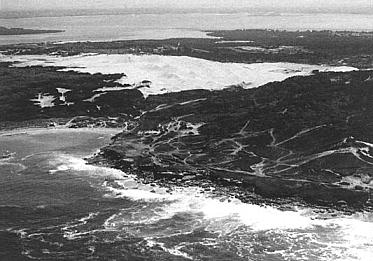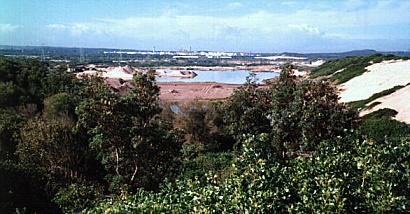Industry Intrudes |
Sandmining
The effects of 'development' are still being worked out as considerable sand extraction continues on the peninsula The sand has been long valued by the building industry because of its high crushed shell content and lack of organic matter. The sand dunes of Kurnell have provided a cheap source of sand for much of Sydney, but as a result of this exploitation Kurnell has been robbed of its original character. Removal of the sand has significantly weakened the peninsula's capacity to resist storms. Ocean waves pounding the reduced Kurnell dune system have threatened to break through to Botany Bay, especially during the storms of May-June 1974 and August 1998. |
 |
| Sand from the dunes on the throat of Kurnell headland has been extracted since the 1930s when the State Government granted mining leases on freehold and Crown Land. In April 1937, Haymarket Land and Building Co. offered Sutherland Shire Council 720 acres of land at the entrance to Kurnell for 8 per acre. Many of the councillors wished to create a National Park at Kurnell, "the Birthplace of Australian History and Gateway to Captain Cook's Landing Place", and to include in it the dunes and Towra Point. The Council was evenly split, but C. O.J. (Joe) Monro, the Council's President [today termed Mayor], argued that because the land "was all sandhills it was completely useless". He cast his deciding vote against the purchase. The sandhills were doomed from that point. |

 |
Sand deposits are still being worked, in 1999, by three privately owned companies:
-
Metropolitan Sand Company and Processed Sand Pty Ltd, both part of the group controlled by T. E. Breen. In 1952, a builder asked Breen, who was working as a reporter, where he could get large quantities of dry sand. This simple enquiry triggered Breen to research all aspects of sand usage and mining. The Breen sand extraction companies commenced mining in 1953.
-
Pioneer Concrete (NSW) Pty Ltd, under lease from Besmaw Pty Ltd, one of the Holt group of companies. The Holt family has owned Kurnell land since 1861, and sand mining on their land began as Allsands in 1953.
-
Hooker Industrial Sands, now Metromix, mined sand since 1967 on land leased from Australian Consolidated Developments, another of the Holt group.
Sand has also been extracted periodically from Crown Lands by both the local council and the state government. Crown Land adjoining Sir Joseph Banks Drive, notified as a Public Recreation Reserve in 1949, had this notification revoked in 1965. It was then designated a Reserve for Future Public Requirements in expectation of sand extraction and industrial development ceasing. However, as the twentieth century draws to a close, the sandminers, finding their resources dwindling, are looking to further profit from the stripped land by building residential housing or recreational resorts or industrial complexes. |
 |
| top of page |



